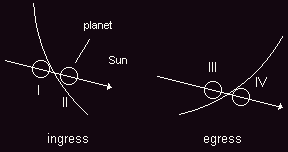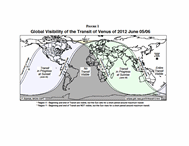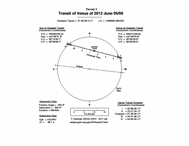![]()
- - text and links as of last publication - -
| A Rare Event! How Does a Transit Unfold? |
2012 Transit Locations and Times Observation Techniques |
| CAUTION! OBSERVING A VENUS TRANSIT AGAINST THE BACKGROUND OF THE SUN IS DANGEROUS AND MAY CAUSE IRREVERSIBLE EYE DAMAGE, UP TO BLINDNESS! Observing a Venus transit necessitates THE SAME DEDICATED SAFE TECHNIQUES USED FOR OBSERVING THE SUN OR SUN ECLIPSES! |
On June 5-6th, 2012 a rare astronomical event occurs, with Venus transiting on Sun's disk. Venus transits occur by pair in a 8-year row, as the last one occurred in 2004. Such a pair only occur on large scales of time, as last Venus series of transits occurred in 1882 as next one will not happen now until in 2117-2125! If you are favourably located as a observer, do not miss that last occasion before a century -and the last of the 21st century! The 2004-2012 series of transits is the fourth only since telescopic era began. That transit is labelled June 5-6th as it begins on June 5 and ends of June 6 UT. For people out of where the show takes place, or in case of bad weather, sites are usually scheduled to webcast such a event (see at page's end). Venus transits are much rarer than Mercury's, and occur in pair about each century. This means that when about a century (precisely between 105 and 121 years) has elapsed, two Venus transits occur in a row, only separated by 8 years. This 2012 transit e.g. was preceded by the one in 2004. But, now, after 2012, 105 years will elapse before any other transit which will occur on December 11th, 2117 (December, 11th) and then by 2125. Venus transits occur at nodes of Venus orbit and when the planet, at the same time, is at its inferior conjunction, that is when Venus passes where its orbit plane is intersecting Earth's orbit plane and when Venus, at the same time, is located between the Sun and the Earth. It is at such points and moments that there is a chance that the planet be directly seen against the background of the Sun as seen from Earth. Last Venus transits occurred in 1631-1639, 1761-1769 and 1874-1882. A Venus transit is a rare event. Venus transits always occur in early June or early December, which is the time when Venus nodes crossing occur
Venus transits historically were major events until the 19th century as they allowed to accurately measure Sun-Earth distance. It was Edmund Halley who theoretically conceived such a project in the 17th century, assuming that a Venus transit, timed from widely separated locations, would allow this. An accurate Earth-Sun distance in turn was to allow measurement of solar system distances. And even distances to stars as those are imperceptibly seen shifted as seen from one point of Earth's orbit to another. If Earth's orbit diameter is known this allows to measure stars' distances! It was for the transits of 1761-1769 that the first expeditions were organized for the purpose of measuring Sun-Earth distance. The famed English explorer Cook -he was just a lieutenant at that epoch- led one of these expeditions in 1769. He settled in Tahiti island, now a French possession in the Pacific Ocean, as another expedition looked at the event since Hudson Bay, Canada. Today, such Venus transits are remaining useful as transits are part of methods used to detect exoplanets (planets which may exist about other stars), specially Earth-sized ones. Nevertheless, a Venus transit remains a very rare, major event for the amateur astronomers community and it gives a few encountered sense of how our solar system is vast. The neatly round shape of Venus seen moving against the Sun background is literally projecting you into a 3D view of the Sun, Venus and the Earth!
Technically a Venus transit unfolds like a Mercury's one or like a solar eclipse. The transiting planet is moving from the East to the West of the solar disk. The principal events occurring during a transit are conveniently characterized by four so-called 'contacts', analogous to the contacts of an annular solar eclipse. Two are ingress contacts (contact I and II), and two egress ones (III and IV), with a central point which is the time of greatest transit when planet passes at nearest of Sun's center or the 'minimum separation'. The transit begins with contact I, the instant when the planet's disk is externally tangent to the Sun (comes to its first contact to the Sun). After a while, as the transit begins, Venus progressively comes to be seen against the solar disk, passing from a mere notch to the entire disk. When the entire disk of the planet is first seen, this constitutes contact II (or the planet is internally tangent to the Sun). Over the course of several hours, the silhouetted planet slowly traverses the solar disk. Then the reverse occurs. At contact III, the planet reaches the opposite limb and once again is internally tangent to the Sun. From that the disk of Venus progressively disappears passing from a disk to a mere notch and, eventually, the transit ends at contact IV when the planet's limb is externally tangent to the Sun

| CAUTION! As the observation of a Venus transit occurs against the background of the Sun, observation must use the same DEDICATED SAFE TECHNIQUES USED FOR OBSERVING THE SUN OR SUN ECLIPSES! check more from above |
2012 Venus transit is a western Pacific Ocean show as it is there that the transit is observable in its entirety. Regions concerned are found from central Siberia down to central and eastern Australia and about all of New Zealand on a one hand and in the northwesternmost part of North America on the other hand. Eastern halve of China, Japan or the Philippines are also treated with the whole show like are a part of the Pacific Ocean islands. Most of North America, Central America and the northwestern parts of South America have the transit interrupted by sunset as Europe, the Middle East, India, a part of the Southeast and the eastern parts of Africa have the transit already encours at sunrise. A large part of South America and western parts of Africa -with Portugal and the western halve of Spain- do not see the transit of Venus at all
 | see a .PDF map for the visibility of the June 5-6th, 2012 Venus transit (a smaller .gif version is also available). map courtesy Fred Espenak - NASA/GSFC |
Venus will take a usual, long 6h 40 mn to cross the solar disk. Minimum separation (distance between Venus and solar disk's center at the maximum of the transit) will be 554.4" (or 9.2') which is somewhat less than one-third the Sun's apparent diameter. The transit occurs in the Sun northern part. Here are given below the transit official times (all times in UT; time spanning from Jun. 5 to Jun. 6 UT; times may vary up to plus/minus 7 mn according to observer's locations as that is due to effects of parallax since Venus may be shifted up to 30 arc-seconds from its geocentric coordinates depending on the observer's exact position on Earth; observers will also have to take in account the International Date Line). The 'position angle' is defined as the direction of Venus with respect to the center of the Sun's disk, measured counterclockwise from the celestial north point on the Sun
| Contacts | Time (UT) | Position Angle |
|---|---|---|
| contact I | 22:09:38 | 41° |
| contact II | 22:27:34 | 38° |
| minimum separation | 01:29:36 | 345° |
| contact III | 04:31:39 | 293° |
| contact IV | 04:49:35 | 290° |
 | see a .PDF map for the June 5-6th, 2012 Venus transit's data (a smaller .gif version is also available). map courtesy Fred Espenak - NASA/GSFC |
. for more about the June 2012 Venus transit, check at Fred Espenak's NASA's eclipse website
| CAUTION! As the observation of a Venus transit occurs against the background of the Sun, observation must use the same DEDICATED SAFE TECHNIQUES USED FOR OBSERVING THE SUN OR SUN ECLIPSES! check more from above |
Venus, during the transit, is seen with a 58" of apparent diamter or about one arc-minute. Using a solar filter protection it thus may theoretically be seen crossing the Sun naked-eye. At that apparent diameter, it will then look like a small sunspot. A pair of binoculars or a small telescope at modest power will offer a much more satisfying view however. Note that if you are in a part of the Earth where Venus transit is visible at dawn or at sunset, you might be tempted to look directly at a low-hanging Sun. Don't. Sun is dangerous in that case too! Amateurs may make useful timing observations during the transit, like described at NASA/Fred Espenak eclipses' site. That works, in that case, with the A.L.P.O. (Association of Lunar & Planetary Observers). Internal tangent contacts (II et III) are precisely the moments when, after or before the so-called "black drop effect", planet's disk is entirely encircled by Sun's light. Before, the planet and the Sun's limbs are in contact and not dissociated from each other. During 20 to 30 seconds, planet's dark disk is drop-shaped linked to the solar limb and looking like to be attached to there by a thin column or thread, which is a natural optical effect which you can verify pinching your thumb and index fingers; just narrow both slowly and you will see, just before they touch, a shadowy bridge springing across the gap. It's a matter of dark-to-bright gradients as, in the case of a transit, it is the result of seeing effects due to Earth's turbulent atmosphere. Contacts II and III are measured when planetary disk is completely dissociated (contact II) or when it stops being dissociated (contact III). It is these contacts which are usually measured. Contact I and IV are not easily observable as planet is still -or again- in Sun's glare. These contacts may be seen however using an H-alpha filter: planet is then seen silhouetting on Sun's prominences or chromosphere. Minimum separation is the center of the transit's course: the planet is at its nearest of solar disk's center, and, at the same time, the farthest from any limb. When the thread breaks and the planet is completely surrounded by sunlight, this marks the true instant of contact II. Atmospheric seeing often makes it difficult to measure contact timings with a precision better than several seconds
Like for any major astronomical event, the important is to get ready as such major events are breathtaking -and lasting a long time. Some days before the event, have a review of what is needed (depending on what kind of observation you will perform -visual, photographic, etc), think about where you will be observing from (for the transit, think of what Sun's course in the sky will be and choose a location where you will be able to see the entirety of the event with the Sun never impeded), and precisely review the event timing. Try to visualise how the transit will unfold. Another major hint is to get comfortable (chair, sunglasses, hat, something to eat and drink, etc). And do not forget that you are going to see a very rare event. Since modern astronomy began, this is the fourth transit series only! If you are not a seasoned amateur astronomer, you might be surprised by sunspots at the Sun. Do not confuse them for Venus! Venus is plainly round-shaped as sunspots are clearly irregular. The presence and density of sunspots number at the time of the transit, function of when the peak of the current 11-year solar cycle of activity is to occur, should be already of a certain importance by the time of the Venus transit. Should the weather be inclement, or should you be in a part of the world where the transit is not observable, webcasts are usually forecasted for such a major astronomical event. No Internet addresses are still available by the time of the release of that page as some hints should be provided in time by such sites like NASA or well-known amateur astronomy sites. The sites of solar orbiting observatories like SOHO or the more recent SDO (and STEREO) are also of use as those missions' sites often provide for views and forecasts of a transit
Website Manager: G. Guichard, site 'Amateur Astronomy,' http://stars5.6te.net. Page Editor: G. Guichard. last edited: 1/1/2012. contact us at ggwebsites@outlook.com